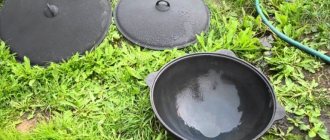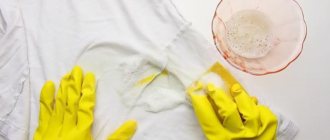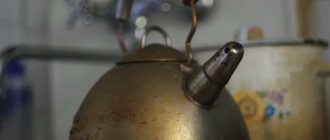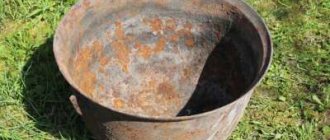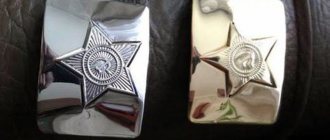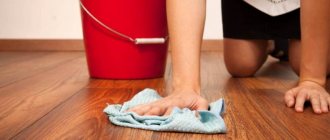Real Uzbek pilaf: the taste and aroma are unsurpassed. But washing a cauldron after a luxurious meal is very difficult. Soot remains on the walls outside, grease remains on the inside, and without proper care, the dishes begin to rust. To prevent this from happening, you need to take care of it. Rust is removed with special mixtures of soap, glue, soda, and vinegar. Scale, soot, and fat are dissolved with detergents followed by boiling. Even a drill with flat attachments is used to clean cast iron.
How to clean an aluminum or cast iron cauldron
The difference between them is in the material of manufacture - duralumin alloy and cast iron. They have different physical characteristics, but they have one thing in common - they retain heat for a long time.
They also get dirty in the same way: Soot is formed due to fat stuck to the walls of the dishes.
A cauldron made of duralumin is easy to clean; a dishwasher can handle this too. The product can be cleaned with soft metal brushes and abrasive detergents. However, duralumin does not tolerate oxalic acid well: the surface ceases to shine and becomes dull.
Cast iron cookware requires careful handling. It should not be cleaned in the dishwasher as it will begin to rust. Cast iron products are afraid of mechanical shock - they can crack or split.
If you clean the cauldron with a metal brush, the oily coating will be damaged: This will reduce the quality characteristics of the cast iron. Periodically, a cast iron product needs to be blued to restore the non-stick layer.
What is a cauldron and what are the features of the dishes?
Traditional Asian dishes are valued by chefs all over the world for their special round shape. Everything is prepared in it:
- Sauces;
- Meat;
- Dessert;
- Fish;
- Rich soups;
- Pilaf is considered a traditional dish.
Kazan is the national dishware of the peoples of Central Asia.
The cauldron is convenient for forays into nature. It is installed:
- On a portable tandoor;
- Tripod over the fire;
- Grill of suitable size;
- Hot coals.
Mix the food in a round bowl well. It absorbs less oil - it flows down the walls to the bottom. It languishes for a long time due to the thick walls, and reaches saturation with aroma. In such a container, food cooks more evenly.
The history of the cauldron goes back many centuries. Since then, its form has hardly changed.
In the East, copper cauldrons were in use; now duralumin and cast iron have become traditional alloys. Metals differ significantly in their physical properties. They are united by high porosity and heat capacity.
The cauldron is convenient for forays into nature.
Composition based on silicate glue and soda
A proven folk method for cleaning dishes from carbon deposits is boiling in a mixture of silicate glue and soda. These substances effectively clean burnt areas without damaging the surface of the dishes.
- For 10 liters of water, take 150 g of glue and soda, mix everything well until completely dissolved.
- It is best to mix the ingredients in a large basin; the dishes are boiled in it over moderate heat.
- Then the fire is reduced as much as possible, the cast iron is left in the basin for about an hour.
- Remove the product and wipe with a soft sponge.
- Cleaning the vessel from carbon deposits will not be difficult, because it quickly moves away from the walls.
- Silicate glue and soda can be replaced with PVA and laundry soap.
- A large bowl of water requires one piece of grated soap and 65 ml of PVA.
- Boil the cast iron in this mixture for about 3 hours, not forgetting to periodically add water.
After cooling, the vessel can be easily cleaned of carbon deposits using a dish sponge (hard side). In case of heavy contamination, it is recommended to repeat the procedure.
Boiling
If the fat layer has already hardened because it was not possible to wash the dishes right away, you can try to remove it by boiling.
To do this, you will need to grate laundry soap and dissolve it in warm water. The bar can be replaced with a liquid product.
The resulting solution is boiled over low heat for several hours, gradually adding water. It is necessary to ensure that it does not have time to boil away.
After finishing the boiling procedure, all that remains is to clean the aluminum cauldron using a hard sponge. Then you should rinse the dishes 2-3 times to remove any remaining soap.
You can wash a cast iron cauldron with a hard brush, and an aluminum cauldron only with the soft side of a sponge.
Inner surface
How to clean the inside of a cauldron? If you need to wash the cauldron, pour a solution of detergent almost to the brim and boil for about 20 minutes.
- During this time, the burnt plaque will soften and can be easily removed with a sponge.
- You can also prepare a soap-soda solution: for five liters of water, take 5 g of grated soap and a couple of tablespoons of soda.
- Boil for about 18-20 minutes. If the cauldron is very dirty, you can boil it longer.
- If you need to wash a cauldron outdoors, then heat a small volume of water in it. The most burnt areas are moistened with water and sprinkled with salt.
- When the water becomes warm, rock the vessel from side to side to wash off any remaining carbon deposits.
Activated carbon is a convenient and quick means for cleaning the inner surface of cast iron. You need to crush 10-20 tablets into powder, wet the walls of the cast iron well and apply the powder to all problem areas. After 3 hours, rinse the cauldron thoroughly with warm water and a sponge. Dry with a towel.
Rust
Regular cleaning of a cast iron pot using available products will prevent rust from appearing.
If it appears, it is necessary to immediately take emergency measures. Removing rust in a timely manner will prevent its spread and corrosion. You won't need to buy a new boiler.
Vinegar + salt + olive oil
It is easy to clean a cast iron cauldron from rust if you have these products in the house. You can prepare a good remedy from them, and there will be no trace of the problem that has arisen.
How to clean rust from a cauldron:
- First, mix vinegar and water in equal proportions. Fill the pot with this solution and leave for 30 minutes. The vinegar essence should completely cover the inner surfaces of the pot.
- Then the cauldron is dried and the following product is used: 1 tbsp. l. salt and 1 tbsp. l. Olive or vegetable oil is mixed and rubbed onto cast iron. You can use a hard sponge and thoroughly rub the pot.
After achieving the desired result with this cleanser, wash the cauldron with water.
Potato
This vegetable is not only tasty, but also effective against rust on cast iron or aluminum products.
Peel the potatoes, cut them in half and rub the cut areas on the problem areas. Clean in this manner until the rust is completely removed.
You don’t have to throw away the peel, lay it cut side down on the bottom of the cauldron, leave it for a couple of hours and then rinse it with water. The pot will sparkle clean.
Potatoes will eliminate the problem of rust for a long time.
Sanding with Pemolux
If the issue with rust is still relevant and folk remedies have not brought the desired result, it is possible to use household chemicals.
You can use any industrial chemicals for microwaves, ovens and stoves. But Pemolux works best.
How to remove rust from a cast iron cauldron:
- First you need to wash the cauldron using a cloth and detergent.
- Then Pemolux is applied to it with a regular sponge.
- Leave for a while and rinse thoroughly with water.
Motorists use the same method to remove rust from the roof and car doors.
Domestos
From modern chemistry, it is recommended to use Domestos. It is universal, suitable for washing bathtubs, taps, and can also be used to clean heavy dirt from cast iron frying pans and pots.
You will need a large container into which you can completely immerse the cauldron. Domestos is diluted with water in a ratio of 5:1.
The cauldron is lowered into the prepared solution for 2–3 hours. Then they take it out and wash it with warm water. You may need to rinse several times with clean water.
Domestos cannot be used often. Still, this remedy is harmful to health.
After using Domestos, the cauldron may smell unpleasant. Citric acid or the juice of 1 lemon will help eliminate the smell. This will also additionally clean the cauldron of fat.
How to properly care for a cauldron
Cast iron alloys do not withstand aggressive cleaning for the following reasons:
- The non-stick layer is erased;
- The porous structure of cast iron becomes clogged with detergent residue and is difficult to rinse.
If you remove fatty food from the cauldron immediately after cooking, then just rinse the vessel with warm water and wipe dry. If this cleaning method does not give results, how to clean a burnt cauldron? Pour water to a third of the depth of the vessel and boil under the lid. Then the water is drained and the walls are wiped dry with a soft sponge.
Note! If cast iron products are properly cared for, they will last for many years.
Store cast iron cookware in a dry place in an oiled cloth. The cauldron should be protected from high humidity to prevent rust from forming. After this, the dishes will be unsuitable for cooking.
Top 5 household chemicals
You can put a cauldron in order not only with the help of folk recipes. Let's look at the most popular household chemicals among housewives:
- Grease remover "Shumanit". Quickly removes not only fat, but also hardened pieces of food, burnt sugar, soot and carbon deposits. After application, the active components literally break down dirt molecules in just a few minutes, turning them into an easily removable liquid.
- Grease remover "Unicum". Designed for quick and effective cleaning of stoves, grills, pots, cauldrons and frying pans. The unique formula quickly removes soot and soot. With regular use, a protective surface is formed on the dishes, which prevents the following contamination.
- Miracle paste "Doctor Beckham". This household chemical product is one of the most environmentally friendly. Designed to remove any contaminants from any surfaces. The active components clean and polish, forming a water-repellent film.
- Chrome Spray. This universal cleaning spray is ideal for removing any dirt on any surface. The composition is based on citric acid. From the first use, a protective antibacterial film is formed.
- Unicum Grizzly, a product for removing grease, scale and any other types of dirt. Apply to the surface as a spray. After contact with the dishes, foam immediately forms. While the reaction is going on, you should not touch the cauldron. As soon as the surface “calms down! You will need to rinse thoroughly under warm water.
There is nothing difficult about cleaning a cauldron. Especially if you know what tools to use.
https://youtu.be/it8Hex7LjZc
Caring for new cast iron cookware
Before cooking for the first time, a new cast iron cauldron should be prepared:
- Remove technical grease;
- Create a protective oil layer.
How to clean a new cauldron from machine oil? To do this you need to do the following:
- Wash the vessel with soapy water;
- Heat over the fire until the machine oil mixture completely evaporates.
You can heat the cast iron at home on a gas stove or in the oven, but it is preferable to do it outside. During calcination, pungent, strong-smelling smoke is released, which can harm the lungs.
To fire cast iron outdoors, you will need a barbecue or a fire. When the vessel begins to smoke, a lot of black smoke and burning will be released: this is normal. Calcination is considered complete as soon as the color of the product becomes dark gray instead of blue-black.
The fire should be extinguished, the cast iron should be cooled and rinsed in running water. Remember to wipe cast iron items dry after washing and store them in a dry place.
Properly seasoned cast iron cookware does not require a non-stick coating. Such cauldrons are more durable during the cooking process, are easy to clean and last a long time.
Calcination
Calcining the boiler is an “old-fashioned” method of washing cast iron kitchen utensils. If you don’t want to take it home dirty, you can heat it up on a hike.
How to wash a cauldron:
- The pot is completely filled with sand and placed on low heat overnight if you took an electric stove with you. You can also put it on a fire and add more wood during the night to keep the fire going. In the morning, all that remains is to pour out the sand and wash the dishes with detergent.
- Pour 2 kg of salt into a dry cauldron, put it on fire and calcine for 2 hours. During the process, it is necessary to mix the contents of the container. Salt eats away fat. After the manipulation is completed, it will turn black. The procedure can be repeated several times.
Calcination takes longer. It is also less effective than other folk remedies that help clean a cauldron at home.


